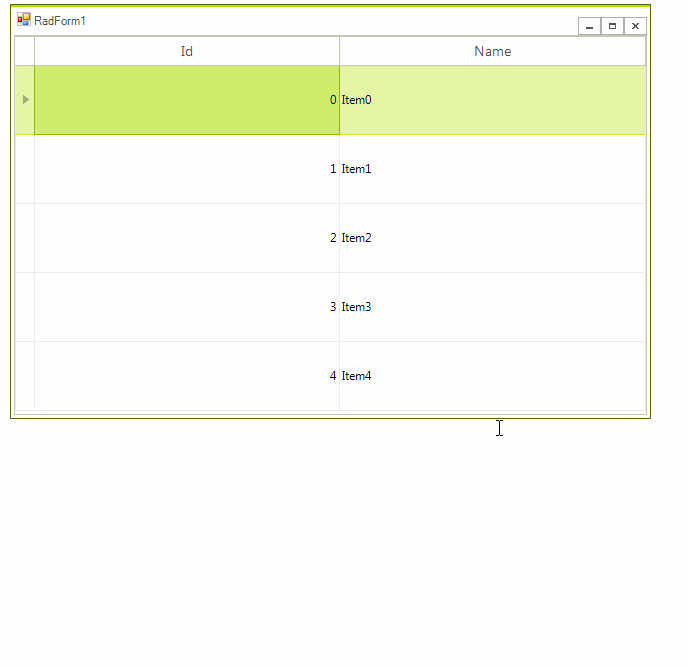How to auto-size the rows to fill the grid's height
Environment
| Product Version | 2018.3.911 |
| Product | RadGridView for WinForms |
Description
RadGridView allows you to adjust the columns' width automatically to fill the entire width of the control. This is controlled by the AutoSizeColumnsMode property. This article will demonstrate a sample approach how to achieve a similar functionality for the rows. In other words, it shows how to adjust the rows' height to fill the height of the control.

Solution
The TableElement.RowHeight property controls the height of the rows in the grid. The following code snippet calculates the RowHeight considering the current size of RadGridView and rows count:
public RadForm1()
{
InitializeComponent();
DataTable dt = new DataTable();
dt.Columns.Add("Id", typeof(int));
dt.Columns.Add("Name", typeof(string));
for (int i = 0; i < 5; i++)
{
dt.Rows.Add(i, "Item" + i);
}
this.radGridView1.DataSource = dt;
this.radGridView1.AutoSizeColumnsMode = Telerik.WinControls.UI.GridViewAutoSizeColumnsMode.Fill;
this.radGridView1.AutoSizeColumnsMode = Telerik.WinControls.UI.GridViewAutoSizeColumnsMode.Fill;
this.radGridView1.ShowGroupPanel = false;
this.radGridView1.EnableFiltering = false;
this.radGridView1.AllowAddNewRow = false;
this.radGridView1.AutoSizeColumnsMode = Telerik.WinControls.UI.GridViewAutoSizeColumnsMode.Fill;
this.radGridView1.SizeChanged += radGridView1_SizeChanged;
}
private void radGridView1_SizeChanged(object sender, EventArgs e)
{
AdjustRowHeight();
}
private void AdjustRowHeight()
{
int rowHeight = (this.radGridView1.Size.Height - this.radGridView1.TableElement.TableHeaderHeight) / this.radGridView1.ChildRows.Count;
if (rowHeight > 0)
{
this.radGridView1.TableElement.RowHeight = rowHeight;
}
}
private void RadForm1_Load(object sender, EventArgs e)
{
AdjustRowHeight();
}
Sub New()
InitializeComponent()
Me.RadGridView1.DataSource = Nothing
Dim dt As DataTable = New DataTable()
dt.Columns.Add("Id", GetType(Integer))
dt.Columns.Add("Name", GetType(String))
For i As Integer = 0 To 5 - 1
dt.Rows.Add(i, "Item" & i)
Next
Me.RadGridView1.DataSource = dt
Me.RadGridView1.AutoSizeColumnsMode = Telerik.WinControls.UI.GridViewAutoSizeColumnsMode.Fill
Me.RadGridView1.AutoSizeColumnsMode = Telerik.WinControls.UI.GridViewAutoSizeColumnsMode.Fill
Me.RadGridView1.ShowGroupPanel = False
Me.RadGridView1.EnableFiltering = False
Me.RadGridView1.AllowAddNewRow = False
Me.RadGridView1.AutoSizeColumnsMode = Telerik.WinControls.UI.GridViewAutoSizeColumnsMode.Fill
AddHandler Me.RadGridView1.SizeChanged, AddressOf radGridView1_SizeChanged
End Sub
Private Sub radGridView1_SizeChanged(ByVal sender As Object, ByVal e As EventArgs)
AdjustRowHeight()
End Sub
Private Sub AdjustRowHeight()
Dim rowHeight As Integer = (Me.RadGridView1.Size.Height - Me.RadGridView1.TableElement.TableHeaderHeight) / Me.RadGridView1.ChildRows.Count
If rowHeight > 0 Then
Me.RadGridView1.TableElement.RowHeight = rowHeight
End If
End Sub
Private Sub RadForm1_Load(sender As Object, e As EventArgs) Handles MyBase.Load
AdjustRowHeight()
End Sub
If some of the system rows are displayed as well, their height should participate in the calculation. You can access a system row by the respective property exposed in the MasterView.